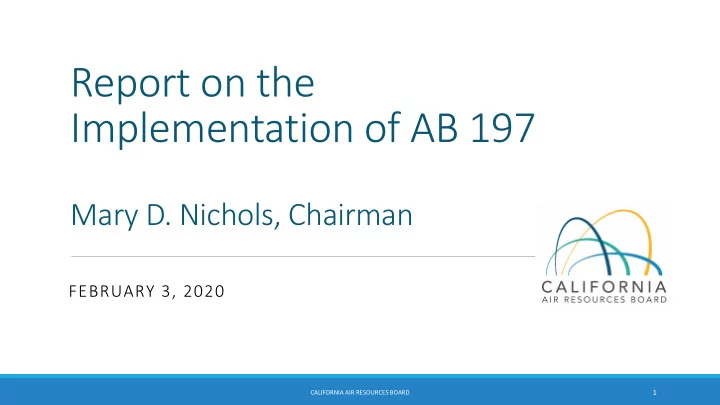

Report on the Implementation of AB 197 Mary D. Nichols, Chairman FEBRUARY 3, 2020 1 CALIFORNIA AIR RESOURCES BOARD
Air Quality Successes – Criteria Pollutants • NOx emissions have steadily declined since 1970s • Reductions are due to improvements in vehicle efficiency and advancements in stationary source engine and stack emission control technologies NOx Statewide Emissions Trend (tons/day) 4,000 3,000 2,000 1,000 0 STATIONARY AREAWIDE ON-ROAD MOBILE OTHER MOBILE 2
Air Quality Successes – Toxic Air Contaminants Substantial statewide toxic air contaminant reductions have occurred since the early 1990s due to Federal (Clean Air Act), State (Air Toxics Control Measures) and local air district regulations (stationary source reductions). Hexavalent Chrome Benzene 1,3-Butadiene Air Monitor Trend Air Monitor Trend Air Monitor Trend 0.4 0.6 4 Parts per billion Parts per billion Parts per billion 0.3 3 0.4 0.2 2 0.2 0.1 1 0 0 0 1985 1995 2005 2015 1985 1995 2005 2015 1985 1995 2005 2015 Lead Perchloroethylene Diesel PM Air Monitor Trend Air Monitor Trend Micrograms per cubic meter Air Monitor Trend Nanograms per cubic meter 40 3 0.6 Parts per billion 30 2 0.4 20 0.2 1 10 0 0 0 1985 1995 2005 2015 1985 1995 2005 2015 1985 1995 2005 2015 3
Growing and Cleaner Economy: California’s Trends 60% GDP 40% Change Since 2000 20% Population 0% GHG Emissions -20% GHG Emissions per Capita -40% GHG Emissions per GDP -60% 2000 2001 2002 2003 2004 2005 2006 2007 2008 2009 2010 2011 2012 2013 2014 2015 2016 2017 Source: 2019 Edition, California Greenhouse Gas Emission Inventory: 2000-2017 CALIFORNIA AIR RESOURCES BOARD 4
Transportation Sector: Largest source of GHG and NOx Emissions Source: 2019 Edition, California Greenhouse Source: CARB Emission Inventory Source: CARB Emission Inventory Gas Emission Inventory: 2000-2017 5 CALIFORNIA AIR RESOURCES BOARD
Transportation Sector: Critical New Paradigm Necessary Aggressive strategies needed to meet National air quality standards, SB 32 GHG requirements, and carbon neutrality in 2045 By 2045: Goal is zero-emission transportation sector through transformative action ZEVs, coupled with Sustainable infrastructure that communities that increases climate improve travel choices resiliency and reduce VMT * When accounting for in-state fuel production 6 CALIFORNIA AIR RESOURCES BOARD
Transportation Sector: Targets for Pathway to Zero-Carbon Widespread Electrification By 2035: 100% new car sales are ZEVs; All school buses, marine port & • airport equipment are ZEVs By 2045 : All passenger vehicles on the road are ZEVs • Increased Transportation Options to Reduce VMT By 2035: Reduce vehicle miles traveled per capita by 25% • By 2045: High-quality, efficient travel options for all Californians • 7 CALIFORNIA AIR RESOURCES BOARD
Transportation Sector: State Actions to Achieve Targets Supporting Requirements Financial Programs • Vehicles • Incentives for • State • Fleets veh’s & chargers investments • SB 375 SCSs • Outreach and education 8 CALIFORNIA AIR RESOURCES BOARD
Carbon Neutrality Sources Sinks Fossil Energy Carbon capture and sequestration Industrial Processes Sources Direct air capture Natural and working = lands Natural and working Sinks lands 9 CALIFORNIA AIR RESOURCES BOARD
Options to Sequester Carbon (sinks) Carbon capture and sequestration (CCS) Capture and store carbon from large emitters (cement, refineries) Direct Air Capture Capture and store carbon from the atmosphere Natural and working lands Emit greenhouse gases, must be managed to emit less and store more carbon over time 10 CALIFORNIA AIR RESOURCES BOARD
Wildfire Acreage, 2001 - 2014 Mastication 1% Thinning Clearcut 8% Harvest Other Mechanical 5% Mastication Wildfire Other Harvest 74% 6% Other Mechanical Clearcut Prescribed Fire 3% Other Wildfire 0% Prescribed Fire 3% Source: California Air Resources Board 11 CALIFORNIA AIR RESOURCES BOARD
Wildfire Emissions 50 45.7 45.5 45 (million metric tons) 40 36.7 CO 2 Emissions 35 30 25 22.8 22.9 21.2 19.2 19.2 20 15.9 15.2 14.4 13.9 15 9.6 10 6.7 6.1 5.4 5 3.5 2.1 1.4 0 2000 2001 2002 2003 2004 2005 2006 2007 2008 2009 2010 2011 2012 2013 2014 2015 2016 2017 2018 Year Source: California Air Resources Board 12 CALIFORNIA AIR RESOURCES BOARD
GHG Accounting Practices To date Per AB 32, GHG Inventory and GHG targets only include fossil emissions Natural and working lands inventory published separately Looking forward for achieving Carbon Neutrality Per IPCC, impacts from both fossil and natural and working lands emissions matter 13 CALIFORNIA AIR RESOURCES BOARD
Thank you 14 CALIFORNIA AIR RESOURCES BOARD
Recommend
More recommend